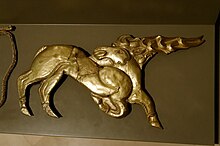
Eurasian nomads form groups of nomadic peoples who have lived in various areas of the Eurasian Steppe. History largely knows them via frontier historical sources from Europe and Asia.[1]
The steppe nomads had no permanent abode, but travelled from place to place to find fresh pasture for their livestock. The generic designation encompasses the varied ethnic groups who have at times inhabited steppe regions of present-day Kazakhstan, Kyrgyzstan, Tajikistan, Turkmenistan, Uzbekistan, Mongolia, Russia, and Ukraine. They domesticated the horse around 3500 BCE, vastly increasing the possibilities of nomadic lifestyle,[2][3][4] and subsequently their economies and cultures emphasised horse breeding, horse riding, and nomadic pastoralism; this usually involved trading with settled peoples around the edges of the steppe. They developed the chariot,[5] the wagon,[6]cavalry, and horse archery, and introduced innovations such as the bridle, bit, stirrup,[7] and saddle. The very rapid rate at which innovations crossed the steppelands spread these innovations widely, making them available for copying by settled peoples living in areas bordering the steppes. During the Iron Age, Scythian cultures emerged among the Eurasian nomads, which were characterized by a distinct Scythian art.
- ^ the Steppe at the Encyclopædia Britannica - "steppe peoples left very little writing for historians to use, and Chinese, Middle Eastern, and European records tell only what happened within a restricted range across their respective steppe frontiers."
- ^ Matossian Shaping World History p. 43
- ^ "What We Theorize – When and Where Domestication Occurred". International Museum of the Horse. Archived from the original on 2016-07-19. Retrieved 2015-01-27.
- ^ "Horsey-aeology, Binary Black Holes, Tracking Red Tides, Fish Re-evolution, Walk Like a Man, Fact or Fiction". Quirks and Quarks Podcast with Bob Macdonald. CBC Radio. 2009-03-07. Retrieved 2010-09-18.
- ^
Lindner, Stephan (April 2020). "Chariots in the Eurasian Steppe: a Bayesian approach to the emergence of horse-drawn transport in the early second millennium BC". Antiquity. 94 (374): 361–380. doi:10.15184/aqy.2020.37. ISSN 0003-598X. S2CID 216205961.
[...] this article demonstrates that [...] early European chariots date to no later than the first proto-chariots of the ancient Near East. This result suggests the earlier emergence of chariots on the Eurasian Steppe than previously thought [...].
- ^
Haarmann, Harald (21 September 2020). "The Wheel, the Wagon, and the Chariot: Dynamics of Technological Transfer in Antiquity". Advancement in Ancient Civilizations: Life, Culture, Science and Thought. Jefferson, North Carolina: McFarland. p. 49. ISBN 9781476640754. Retrieved 19 October 2024.
Experiments with the wheel and the wagon were made in a natural environment that favored the free movement of wheeled vehicles, the steppes. It is especially noteworthy that technicians in those advanced civilizations that had established trade relations with the steppe people took due notice of the new technology and quickly recognized its immense potential. [...] the need for efficient transport facility beyond the use of pack animals must have been vital in communities with mobile life ways since local groups were accustomed to move from one camp site to another, depending on the seasonal movement of the herds in search of favorable pastures. Given the flatness of the steppes terrain, the innovation to introduce wheeled wagons as transport vehicles seems conclusive for such an ecological environment. [...] The time window for the origins of wheeled vehicles opens between ca. 4000 and ca, 3500 BCE. Archaeological evidence [...] comes from areas on the north-eastern periphery of the Danube civilization, dating to a period between 3500 and 3350. This area had been infiltrated by Indo-European migrants of the second out-migration from the steppes, Kurgan II.
- ^
For example:
"Stirrups". The Applied History Research Group, The University of Calgary. Archived from the original on 18 October 2013. Retrieved 19 October 2024.
Some scholars believe that the first true stirrups were devised in Central Asia during the first century BCE by a nomadic group known as the Sarmatians. This innovation soon spread to other Central Asian peoples, who would have quickly noted that bracing one's feet in a set of stirrups made it much easier to shoot a bow from the saddle. [...] Invaders from Central Asia, such as the Huns, brought the stirrup to Europe [...].